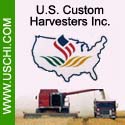 |
 |

|
|
|
Kansas Ag News Headlines |
 |
Producers Emphasize Critical Need for Moisture for Western Kansas Wheat
Kansas Ag Connection - 05/07/2021
Last week's rainfall brought much-needed moisture to some Kansas wheat fields but left other producers in the far-western part of the state saying, "rain, rain, come again." As the Kansas wheat crop continues to mature and flag leaves start to emerge, timely moisture is once again the most critical need to bring this year's crop to harvest.
"We are a week of 100-degree temperatures away from a disaster, or with a few timely rains, we could have an almost normal yield," said Ron Suppes, wheat farmer in Dighton.
Suppes reported his wheat crop developed a pretty good stand last fall despite limited moisture. However, that subsoil moisture has now been depleted. The front last week provided limited relief in his area.
For the week ending May 2, the U.S. Department of Agriculture's National Agricultural Statistics Service (USDA's NASS) reported 27 percent of topsoil and subsoil moisture supplies to be very short-short and 73 percent adequate to surplus.
In the same report, NASS stated jointing for the winter wheat crop is ahead of last year at 83 percent. Twelve percent of winter wheat has now headed, behind the five-year average of 27 percent. Overall, NASS also reported winter wheat condition across the state at 14 percent very poor-poor, 31 percent fair and 55 percent good-excellent.
Planting date and catching scattered moisture have influenced the condition of individual fields this year, even within counties. Jason Ochs, secretary-treasurer of the Kansas Wheat Commission and farmer from Syracuse, reported wheat in his area is highly variable, with some fields zeroed out from insurance and others looking very good. Last week's rains skipped over his part of the state, with only a few isolated places receiving .30-.40 inches. More rainfall will be needed to keep the best fields above average.
"We caught a nice rain at planting time, but it did not last long, and some of the late-planted wheat didn't get a good start," Ochs said. "We caught a nice rain a month or so ago. This made it possible to have a crop."
The Wheat Quality Council will be assessing both winter wheat conditions and disease pressure across the state during the annual Hard Winter Wheat Tour May 17 to 20. The tour will once again take place in person this year, giving participants a firsthand look at this year's wheat crop as scouts examine individual fields from Manhattan to the Colorado border and back again. Learn more about this year's tour at http://www.wheatqualitycouncil.org/wheattours.shtml.
In addition to yield, wheat tour attendees will be assessing disease pressure. While both Suppes and Ochs reported drought conditions have limited pressure in their area, K-State agronomy is encouraging farmers that did receive moisture last week to monitor the crop for wheat streak mosaic virus (WSMV). Additionally, as the crop moves into the flag leaf stage, K-State agronomy is encouraging farmers to assess whether a fungicide application will be needed for stripe rust, with scouts reporting more incidents across the state. Learn more about this guidance at https://eupdate.agronomy.ksu.edu/.
|
 |


|
 |
|
Copyright © 2024 - Farms.com. All Rights Reserved. |
 |
|